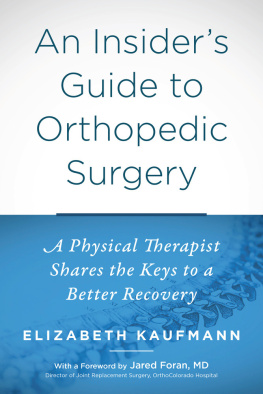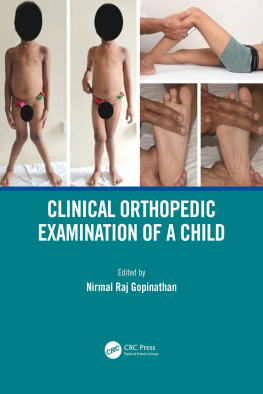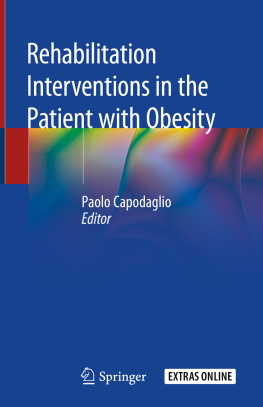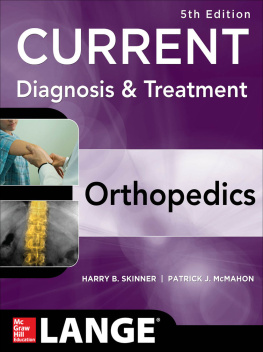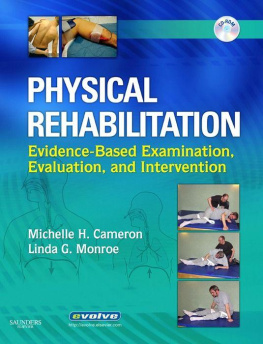Section I
Arthroplasty Rehabilitation
Section II
Hand Rehabilitation
Section III
Pediatric Rehabilitation
Section IV
Spine rehabilitation
Section V
Sports Medicine Rehabilitation
Handbook of Postsurgical Rehabilitation Guidelines for the Orthopedic Clinician
First Edition
JeMe Cioppa-Mosca, PT, MBA
Administrative Editor
Assistant Vice President, Department of Rehabilitation, Hospital for Special Surgery, New York, New York
Janet B. Cahill, PT, CSCS
Administrative Editor
Section Manager, Inpatient Therapy, Department of Rehabilitation, Hospital for Special Surgery, New York, New York
Carmen Young Tucker, PT
Administrative Editor
Director, Inpatient Division, Department of Rehabilitation, Hospital of Special Surgery, New York, New York
Jhon T. Cavanaugh
Deborah Corradi-Scalise
Holly Rudnick
Aviva Wolff
Mosby
Chapter 1 Total Hip Arthroplasty
Carmen Young Tucker, PT, Amie Diamond, PT
Total hip arthroplasty (THA) is one of the most common surgical procedures for the treatment of advanced hip arthritis. More than 254,000 THAs are performed annually. This represents 92 out of 100,000 Americans. The Hospital for Special Surgery (HSS) performs approximately 7000 total joint arthroplasties each year, of which approximately 30% are THA. The primary goals of THA are relief of pain arising from destructive arthritis and improvement in functional mobility. Postoperative rehabilitation is an essential component in the achievement of these goals. The HSS rehabilitation guidelines following THA, which are presented in this chapter, were developed using an evidence-based approach and the clinical expertise of the rehabilitation departments physical therapist.
Surgical Overview
The successful outcome of a THA is based on several factors: patient selection, type of implant, method of fixation, and surgical technique.
The determination of implant selection is individualized and based on specific patient characteristics (i.e., level of activity and bone quality) in addition to the experience of the surgeon.
There is a wide variety of implant designs and materials available. The materials most commonly used for implants are cobalt-chromium and titanium.
Implant surfaces can have different finishes, such as porous-coated, plasma-sprayed surfaces, roughened titanium surfaces, and hydroxyapatite-coated surfaces. The different surfaces may enhance the strength between the implant and cement or fixation of implant to bone.
The type of implant component selected depends on whether the THA will be cemented, porous, or a hybrid.
The profile of the most common THA performed at HSS is a hybrid THA that combines an uncemented acetabular component and a cemented femoral component. This hybrid combination provides excellent results and is more popular in North America.
In addition to the standard THA procedure, HSS is currently using minimally invasive surgery (MIS) on a select group of patients to perform hip arthroplasties.
1 The minimally invasive total hip arthroplasty surgery is a modification of the standard surgical technique performed for THA.
2 An article by Sculco et al. states that with modern techniques, implants, and instrumentation, THA could be performed safely and reproducibly through smaller incisions with increased patient satisfaction and without adversely affecting outcome.
3 The advantages are less soft tissue damage and blood loss.
Several surgical exposures are used for THA.
1 The posterior lateral approach is the predominant choice at HSS.
2 This approach spares the abductors, and a postoperative limp is uncommon.
It has been demonstrated that adequate repair of the capsule and the short external rotator hip muscles reduces the risk of hip dislocation after a posterior approach.
Longevity of the implant depends on activity level of the patient, implant type, method of fixation, and technique of insertion.
At the authors institution, patients undergoing THA are given a combination of spinal/epidural anesthesia, and a few surgeons combine the spinal/epidural anesthesia with a psoas block for enhanced postoperative pain control. A patient-controlled analgesia (PCA) pump attached via a catheter is used to control pain for the initial 24 to 48 hours.
Rehabilitation Overview
The measurement of patient progress addressing functional limitations has been documented in the acute care setting following elective THA.
1 At HSS, the patients functional progress is documented on the HSS Rehabilitation Department Functional Milestones Form. This form was developed to measure functional progression of patients with joint replacements during their hospitalization and has been proven to be statistically valid and reliable.
2 The rehabilitation department has been using the Functional Milestones Form to collect outcome data on the total joint arthroplasty patient population for more than 2 decades.
3 In the early 1990s, the THA clinical pathway and rehabilitation guidelines for phase I were developed using data generated from the Functional Milestones Forms and with the collaboration of HSS surgeons and members of an interdisciplinary team.
4 Phases II and III are progressive phases based on each patients functional mobility, strength, flexibility, gait, and balance, which are objectively measured and assessed by the physical therapist.
Physical therapy management of patients who have undergone a THA is based on the theoretical framework of the disablement model addressing pathology, impairment, functional limitation, and disability.
The most common impairments seen following THA are:
1 Functional strength deficits in the hip musculature,
2 Decreased hip range of motion (ROM),
3 Decreased standing balance and proprioception,
4 Decreased functional activity tolerance, and
5 Increased pain during mobility activities.
Functional limitations typically affect gait, transfers, stair negotiation, driving, and performing basic activities of daily living (ADL).
The disabilities that result are in the areas of self-care, social activities, sporting activities, and work.
Physical therapy treatment approaches following THA are impairment based and focused on reducing pain, increasing strength and flexibility, restoring mobility, teaching adherence to precautions, addressing ADL, and educating the patient and family.
Postoperative Phase I: Acute Care (Days 1 to 4)
GOALS
Transfer unassisted and safely in and out of bed/chair/toilet
Unassisted ambulation with cane(s) or crutches on level surfaces and stairs
Independently perform home exercise program
Demonstrate knowledge and adherence of total hip replacement precautions
Independent with basic ADL
PRECAUTIONS
Avoid hip flexion greater than 90 degrees, adduction past midline, and internal rotation of hip past neutral (for posterior-lateral approach)
Avoid lying on operated side
Avoid pillow(s) under knee to prevent hip flexion contracture
Use abduction pillow when lying supine
Reduce weight-bearing to 2030% if concomitant osteotomy performed
TREATMENT STRATEGIES
Instruct in strengthening exercise to include quadriceps and gluteal isometrics, ankle pumps, hip flexion to 45 degrees in supine; sitting knee extension and hip flexion with hip angle less than 90 degrees; standing hip extension and abduction and knee flexion


